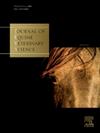垂体中间部功能障碍对纯种马生殖性能的影响。
IF 1.6
3区 农林科学
Q2 VETERINARY SCIENCES
引用次数: 0
摘要
背景:垂体中叶功能障碍(PPID)是一种与年龄相关的疾病,被认为对生育有负面影响。要了解PPID对生育率的真正影响,必须考虑年龄的影响。目的/目的:本研究旨在评估PPID对生育的影响,同时考虑到老龄化的影响。方法:根据2019年和2020年日本北海道Hidaka市137个私人农场管理的332匹10-20岁的纯种马的血浆促肾上腺皮质激素浓度,将其分为PPID、模糊或非PPID。研究了PPID的患病率及其与年龄和血液生化参数(包括催乳素)的关系。进行多变量logistic回归分析,调整潜在混杂因素,包括母马年龄,PPID状态,以评估其对生育力的影响。结果:PPID患病率为9.04%。PPID状态组间催乳素浓度无显著差异。年龄与PPID状态相互作用的校正优势比(AOR)为0.49 (95%CI;0.26-0.91, p=0.02),表明与非PPID母马相比,PPID母马妊娠率的年龄相关性下降更大。在30匹PPID母马中,24匹被分配到治疗组或未治疗组,并在第二年春天监测妊娠结局。治疗组妊娠率为80%(12/15),未治疗组妊娠率为44.4% (4/9)(p=0.10)。治疗后母马妊娠的AOR相对于未治疗母马为2.98 (95%CI;0.26 - -24.61, p = 0.31)。结论:PPID对生育能力有负向影响。本文章由计算机程序翻译,如有差异,请以英文原文为准。
Influence of pituitary pars intermedia dysfunction on reproductive performance in Thoroughbred mares
Background
Pituitary pars intermedia dysfunction (PPID) is an age-related disease considered to have a negative impact on fertility. To understand the true impact of PPID on fertility, the influence of age must be considered.
Aims/objectives
This study aimed to assess the impact of PPID on fertility while accounting for the effect of aging.
Methods
A total of 332 Thoroughbred mares aged 10–20 years and managed across 137 private farms in Hidaka, Hokkaido, Japan were classified as PPID, equivocal, or non-PPID based on plasma adrenocorticotropic hormone concentration in 2019 and 2020. The prevalence of PPID and its associations with age and blood biochemistry parameters, including prolactin, were investigated. Multivariable logistic regression analyses, adjustments for potentially confounders including mare’s age, PPID status were conducted to evaluate their impact on fertility.
Results
The prevalence of PPID was 9.04 %. No significant differences in prolactin concentrations were observed among PPID status groups. The adjusted odds ratio (AOR) for the interaction between age and PPID status was 0.49 (95 %CI; 0.26-0.91, p = 0.02), indicating a greater age-related decline in pregnancy rate in PPID mares compared to non-PPID mares. Of the 30 PPID mares, 24 were assigned to either treated or untreated groups, and monitored for pregnancy outcomes in the following spring. Pregnancy rates were 80 % (12/15) in treated mares and 44.4 % (4/9) in untreated mares (p = 0.10). The AOR for pregnancy in treated mares, relative to untreated mares, was 2.98 (95 %CI; 0.26-24.61, p = 0.31).
Conclusion
PPID was suggested to negatively impact on fertility with aging.
求助全文
通过发布文献求助,成功后即可免费获取论文全文。
去求助
来源期刊

Journal of Equine Veterinary Science
农林科学-兽医学
CiteScore
2.70
自引率
7.70%
发文量
249
审稿时长
77 days
期刊介绍:
Journal of Equine Veterinary Science (JEVS) is an international publication designed for the practicing equine veterinarian, equine researcher, and other equine health care specialist. Published monthly, each issue of JEVS includes original research, reviews, case reports, short communications, and clinical techniques from leaders in the equine veterinary field, covering such topics as laminitis, reproduction, infectious disease, parasitology, behavior, podology, internal medicine, surgery and nutrition.
 求助内容:
求助内容: 应助结果提醒方式:
应助结果提醒方式:


